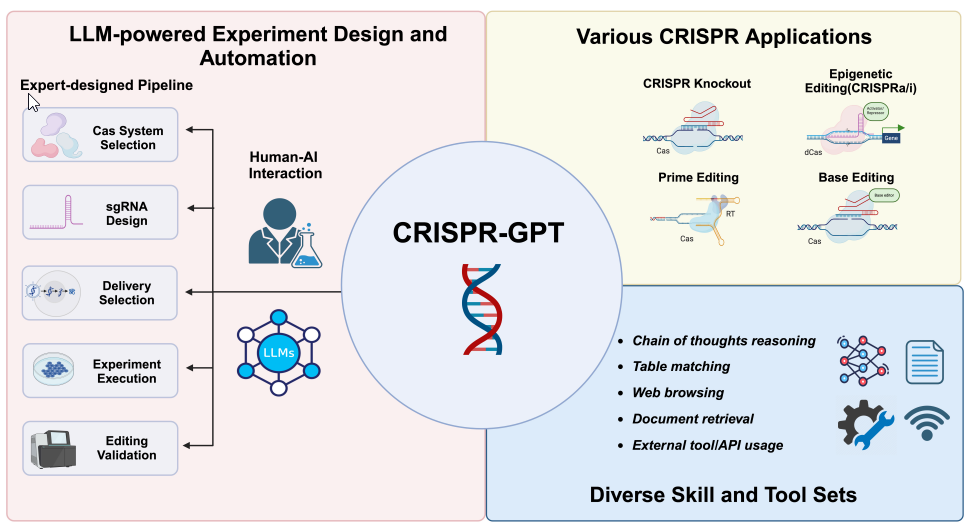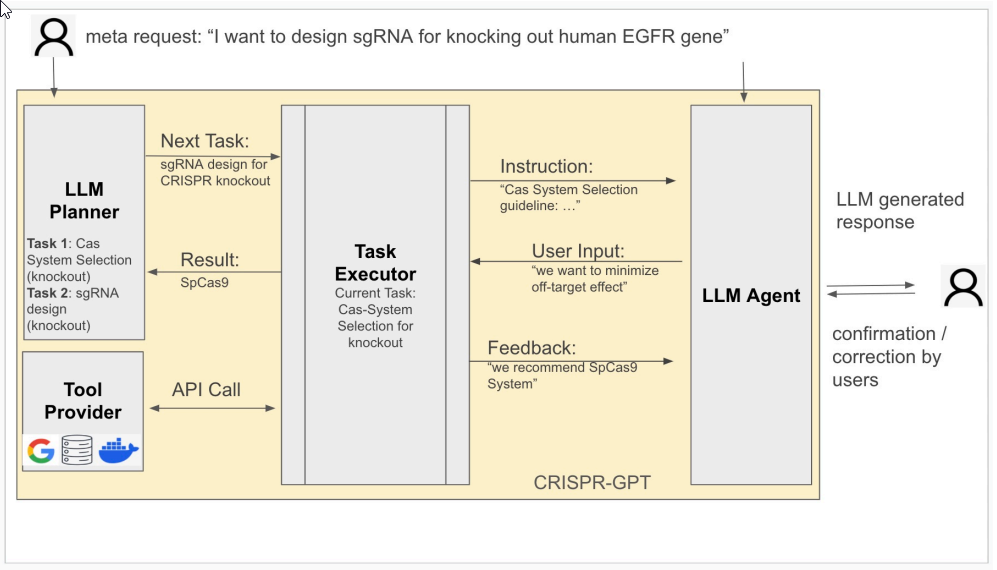Complex gene-editing experiments have traditionally required deep expertise and painstaking planning. Now, CRISPR-GPT is shaking up the status quo by introducing a specialized AI agent that brings powerful automation and smart guidance to the world of CRISPR-based genetic engineering. Researchers, both seasoned and novice, can now streamline experiment design, making advanced genetic manipulation more accessible than ever before.
Key Capabilities of CRISPR-GPT
- Automated Experiment Design: The system handles critical steps like CRISPR system selection, guide RNA (gRNA) design, delivery method suggestions, protocol drafting, and validation planning.
- Deep Biological Intelligence: CRISPR-GPT is trained with domain-specific knowledge, tapping into external databases and research tools for context-rich, reliable information.
- Inclusive User Experience: By bridging knowledge gaps, the platform empowers users without advanced genetics backgrounds to confidently plan and execute gene-editing projects.
- Verified Performance: Expert evaluations consistently ranked its responses above those from general-purpose LLMs, especially in technical accuracy and completeness.
- Lab-Proven Utility: The AI’s recommendations have been validated in live wet-lab settings, demonstrating high editing rates and practical utility.
- Built-In Ethics and Safety: CRISPR-GPT proactively addresses ethical risks, issuing clear warnings and safeguarding sensitive genomic data in line with privacy standards.
Why Specialized AI Is Needed
The precision and complexity of CRISPR gene editing have revolutionized science, yet setting up successful experiments demands detailed protocols and up-to-date knowledge. General AI models often fall short misidentifying gRNA sequences, omitting crucial steps, or missing the latest data. CRISPR-GPT’s targeted expertise ensures reliable, accurate, and safe experiment planning, reducing the risk of errors that could compromise research outcomes.

Figure 1: Overview of CRISPR-GPT Agent. The CRISPR-GPT is built upon an LLMpowered design and planning engine (left), which helps to complete 4 core meta-tasks (top right), as well as other auxiliary functions (freestyle Q&A, off-target prediction). CRISPR-GPT has integrated a set of useful skills and toolkits (bottom right) that the LLM agent would call when needed to facilitate human users across the different tasks and subtasks. Figure created with BioRender.com. Credit: Paper
How the System Operates
- LLM Planner: Breaks down user goals into logical, actionable steps with advanced reasoning methods.
- Tool Provider: Interfaces with research databases, gRNA libraries, and primer design applications for data-rich recommendations.
- Task Executor: Oversees workflow execution, managing task sequences and supporting user queries.
- LLM Agent: Integrates information and presents guidance in clear, concise language.
Users can choose from three modes: Meta Mode for guided workflows, Auto Mode for flexible task creation, and Q&A Mode for instant gene-editing support.
CRISPR-GPT offers three distinct interactive modules for users:
- Meta Mode: This mode provides expertly defined pipelines for common gene-editing scenarios (referred to as Meta-tasks). It guides users through predefined steps like CRISPR system selection, delivery method recommendation, gRNA design, off-target effect prediction, protocol selection, and validation planning.
- Auto Mode: This mode automatically generates a tailored list of necessary design tasks based on a user's initial input, dynamically breaking down requests into dependent tasks using the LLM-planner.
- Q&A Mode: Functioning as an advanced chatbot, this mode allows users to ask ad hoc queries related to CRISPR and gene editing, providing immediate, precise responses by leveraging its knowledge base and document retrieval capabilities.

Figure 2: Components of CRISPR-GPT enable human-AI collaboration to automate gene-editing experimental designs across complex tasks. LLM Planner is responsible for configuring tasks based on the user’s needs (4 predefined meta-tasks or LLM planned chain of tasks). Tool Provider connects the system to external APIs, tools, libraries, and documents. Task Executor is implemented as a state machine, responsible for providing instructions and feedback, receiving input from LLM Agent, and calling APIs via Tool Provider. LLM Agent is responsible for interacting with the task executor on behalf of the user, where the user can monitor the process and provide correction to the LLM agent if the generated content. Credit: Paper
The Impact on Research and Discovery
CRISPR-GPT’s automated planning levels the playing field for researchers, expediting scientific progress and therapeutic breakthroughs. Its step-by-step instructions help users avoid common errors, enhancing experiment reproducibility and quality. The conversational interface supports real-time troubleshooting and collaboration, while robust ethical frameworks ensure responsible use and data privacy, meeting standards like HIPAA compliance.
Real-World Results
Experts rated CRISPR-GPT’s guidance superior to ChatGPT in accuracy, depth, and usefulness. In a notable wet-lab application, the AI guided an independent scientist through a successful gene knockout in human cancer cells, delivering precise recommendations for each experimental stage and yielding high rates of desired edits.
The Future of AI-Driven Labs
CRISPR-GPT points to a future where AI lab assistants help plan, execute, and even automate entire research workflows. While certain complex scenarios remain challenging, this technology marks a pivotal advance toward faster, safer, and more innovative biomedical research—anchored by ethical best practices.
Conclusion
CRISPR-GPT exemplifies how AI is redefining scientific workflows, making cutting-edge gene-editing accessible, reliable, and ethically secure. As AI capabilities expand, researchers can look forward to even greater efficiencies and breakthroughs in the life sciences.

CRISPR-GPT Is Transforming Gene-Editing Design with AI
CRISPR-GPT: An LLM Agent for Automated Design of Gene-Editing Experiments